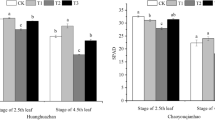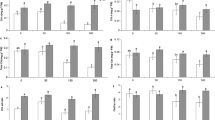Abstract
Salt stress has an important influence on the growth and development of gourd (Lagenaria siceraria (Molina) Standl.), and it is one of the abiotic factors that inhibit plant growth. As a plant growth regulator, brassinolide has a regulatory effect on plants under salt stress. In this study, “Yayao” gourd was treated with 85 mmol/L NaClstress to study the alleviation effect of different concentrations of brassinolide on ornamental gourd. The results showed that the concentration of brassinolide at 0.208 μmol/L under salt stress significantly increased the net photosynthetic rate, transpiration rate, stomatal conductance and chlorophyll content, regulated fluorescence parameters, and improved plant height, dry and fresh weight and root vigor of gourd seedlings under salt stress. Brassinolide increased soluble sugar content, decreased free proline content, promoted antioxidant enzymes (SOD, APX, CAT) activity, eliminated reactive oxygen species (ROS) damage, reduced malondialdehyde (MDA) accumulation, maintained cell expansion pressure, improved cell-environment osmoregulation, and inhibited membrane lipid peroxidation in gourds. In addition, salt stress increased the content of phenolic compounds, flavonoids, and lignin, and brassinolide further increased the content, which alleviated the damage of salt stress. The above analysis showed that salt stress had a certain effect on the physiological indexes of gourd seedlings, and the appropriate concentration of brassinolide could alleviate the damage of salt stress on gourd seedlings from several aspects.







Similar content being viewed by others
REFERENCES
Yadav, S., Irfan, M., Ahmad, A., and Hayat, S., Causes of salinity and plant manifestations to salt stress: a review, J. Environ. Biol., 2011, vol. 32, p. 667.
Yakup, Z., Tiyip, T., Nurmemet, I., Sawut, M., Abliz, A., and Abdujappar, A., Monitoring of soil salinization in yutian oasis based on target polarimetric decomposition method and palsar radar data, Laser & Optoelectronics Progress, 2017, vol. 54, p. 294. https://doi.org/10.3788/LOP54.062803
Jiang, H., Rusuli, Y., Kadeer, R., and Adilai, W., Evaluation and analysis of soil salinization in the arid zones based on neural network model, Geo-Inf., 2017, vol. 19, p. 983. https://doi.org/10.3724/SP.J.1047.2017.00983
Allbed, A., Kumar, L., and Aldakheel, Y.Y., Assessing soil salinity using soil salinity and vegetation indices derived from ikonos high-spatial resolution imageries: applications in a date palm dominated region, Geoderma, 2014, vol. 7, p. 230. https://doi.org/10.1016/j.geoderma.2014.03.025
Grove, M.D., Spencer, G.F., Rohwedder, W.K., Mandava, N., and Cook, J., Brassinolide, a plant growth-promoting steroid isolated from Brassica napus pollen, Nature, 1979, vol. 281, p. 216. https://doi.org/10.1038/281216a0
Baghel, M., Nagaraja, A., and Srivastav, M., Pleiotropic influences of brassinosteroids on fruit crops: a review, J. Plant Growth Regul., 2019, vol. 87, p. 375. https://doi.org/10.1007/s10725-018-0471-8
Li, M., Zhang, Y., Xu, X., Chen, Y., Chu, J., and Yao, X., The combined treatments of brassinolide and zeaxanthin better alleviate oxidative damage and improve hypocotyl length, biomass, and the quality of radish sprouts stored at low temperature, Food Chem., 2022, vol. X 15, p. 100394. https://doi.org/10.1016/j.fochx.2022.100394
Kanwar, M.K., Bakshi, P., Sharma, P., Kour, J., Singh, A.D., Dhiman, S., Ibhrahim, M., Mir, B.A., Ahammed, G.J., and Zhou, J., Brassinosteroids in plant reproductive development, Brassinosteroids in Plant Developmental Biology and Stress Tolerance, Academic Press, 2022, p. 105. https://doi.org/10.1016/B978-0-12-813227-2.00009-6
Hong, J., Sung, J., and Ryu, H., Brassinosteroids-mediated regulation of ABI3 is involved in high temperature induced early flowering in plants. J. Plant Biotechnol., 2018, vol. 45, p. 83e89. https://doi.org/10.5010/JPB.2018.45.2.083
Sophie, D. D., Brian, F., Loïc, P., Price, A., Tuberosa, R., and Draye, X., Root system architecture: opportunities and constraints for genetic improvement of crops, Trends Plant Sci, 2007, vol. 12, p. 474. https://doi.org/10.1016/j.tplants.2007.08.012
Li, Q.F., Lu, J., Yu, J.W., Zhang, C.Q., He, J.X., and Liu, Q.Q., The brassinosteroid-regulated transcription factors BZR1/BES1 function as a coordinator in multi signal-regulated plant growth, Biochim. Biophys. Acta (BBA): Gene Regul. Mech., 2018, vol. 1861, p. 561e571. https://doi.org/10.1016/j.bbagrm.2018.04.003
Zaharah, S.S., Singh, Z., Symons, G.M., and Reid, J.B., Role of brassinosteroids, ethylene, abscisic acid, and indole-3-acetic acid in mango fruit ripening, J. Plant Growth Regul., 2012, vol. 31, p. 363e372. https://doi.org/10.1007/s00344-011-9245-5
Ayub, R.A., Reis, L., Bosetto, L., Lopes, P. Z., Galvo, C. W., and Etto, R. M., Brassinosteroid plays a role on pink stage for receptor and transcription factors involved in strawberry fruit ripening, J. Plant Growth Regul., 2018, vol. 84, p. 159e167. https://doi.org/10.1007/s10725-017-0329-5
Huang, H., Wang, D., Belwal, T., Dong, L., Lu, L., Zou, Y., and Luo, Z., A novel W/O/W double emulsion co-delivering brassinolide and cinnamon essential oil delayed the senescence of broccoli via regulating chlorophyll degradation and energy metabolism, Food Chem., 2021, vol. 356, p. 129704. https://doi.org/10.1016/j.foodchem.2021.129704
Dehghan, M., Balouchi, H., Yadavi, A., and Zare, E., Improve wheat (Triticum aestivum) performance by brassinolide application under different irrigation regimes, S. Afr. J. Bot., 2020, vol. 130, p. 259. https://doi.org/10.1016/j.sajb.2020.01.013
Mashilo, J., Odindo, A.O., Shimelis, H.A., Musenge, P., Tesfay, S.Z., and Magwaza, LS., Drought tolerance of selected bottle gourd [Lagenaria siceraria (Molina) Standl.] landraces assessed by leaf gas exchange and photosynthetic efficiency, Plant Physiol. Biochem., 2017, vol. 120, p. 75. https://doi.org/10.1016/j.plaphy.2017.09.022
Attar, U.A. and Ghane, S.G., In vitro antioxidant, antidiabetic, antiacetylcholine esterase, anticancer activities and RP-HPLC analysis of phenolics from the wild bottle gourd (Lagenaria siceraria (Molina) Standl.), S. Afr. J. Bot., 2019, vol. 125, p. 360. https://doi.org/10.1016/j.sajb.2018.09.006
Omokhua-Uyi, A.G. and Van Staden, J., Phytomedicinal relevance of South African Cucurbitaceae species and their safety assessment: A review, J. Ethnopharmacol., 2020, vol. 259, p. 112967. https://doi.org/10.1016/j.jep.2020.112967
Liu, L., Xiao, W., Ling, D.M., Gao, D.S., Zhu, Y., and Xi, L., Effect of exogenously applied molybdenum on its absorption and nitrate metabolism in strawberry seedlings, J. Plant Physiol. Biochem., 2017, vol. 115, p. 200. https://doi.org/10.1016/j.plaphy.2017.03.015
Lin, K.H., Huang, M.Y., Huang, W.D., Hsu, M.H., and Yang, C.M., The effects of red, blue, and white light-emitting diodes on the growth, development, and edible quality of hydroponically grown lettuce (Lactuca sativa L. var. capitata), Sci. Hortic., 2013, vol. 150, p. 86. https://doi.org/10.1016/j.scienta.2012.10.002
Li, H.S., Principle and Technique of Plant Physiology and Biochemistry Experiment, Beijing: Higher Education Press, 2000.
Wang, X.K., Principles and Techniques of Plant Physiological and Biochemical Experiments, Beijing: Higher Education Press, 2006, 2nd ed.
Cui, H.L., Xie, J.F., Yang, B., Han, Q., Fan, R.J., and Wang, A.A., Effects of Sewage Irrigation and Cadmium Stresses on the Activities of Several Antioxidant Enzymes of Spinach, J. Sci. Technol. Agric. Nat. Resour., 2010, vol. 8, p. 947. https://doi.org/10.4314/ajb.v8i22.66135
Zainudin, M., Hamid, A.A., Anwar, F., Osman, A., and Saari, N., Variation of bioactive compounds and antioxidant activity of carambola (Averrhoa carambola L.) fruit at different ripening stages, Sci.Hortic., 2014, vol. 172, p. 325. https://doi.org/10.1016/j.scienta.2014.04.007
Dence, C.W., The determination of lignin, Methods in Lignin Chemistry, Lin, S.Y. and Dence, C.W., Eds., Springer: Heidelberg, 1992, p. 33. https://doi.org/10.1007/978-3-642-74065-7_3
Zhang, Y.H., Li, X.Y., Šimůnek, J., Shi, H., Chen, N., and Hu, Q., Optimizing drip irrigation with alternate use of fresh and brackish waters by analyzing salt stress: The experimental and simulation approaches, Soil Tillage Res., 2022, vol. 219, p. 105355. https://doi.org/10.1016/j.still.2022.105355
Liang, Q.Y., Wu, Y.H., Wang, K., Bai, Z.Y., Liu, Q.L., Pan, Y.Z., Zhang, L., and Jiang, B.B., Chrysanthemum WRKY gene DgWRKY5 enhances tolerance to salt stress in transgenic chrysanthemum, Sci. Rep., 2017, vol. 7, p. 1. https://doi.org/10.1038/s41598-017-05170-x
Pavlovic, I., Pencik, A., Novak, O., Vujcic, V., and Brkanac, S., Short-term salt stress in Brassica rapa seedlings causes alterations in auxin metabolism, Plant Physiol. Biochem., 2018, vol. 125, p. 74. https://doi.org/10.1016/j.plaphy.2018.01.026
Wang, T., Meng, Z.J., and Zhang, J.P., Effects of NaCl stress on the growth and physiological characteristics of Amorpha fruticosa seedlings, Journal of Northwest Forestry University, 2021, vol. 36, p. 25. https://doi.org/10.3969/j.issn.1001-746.2021.01.04
Huang, L., Yang, W.P., and Liu, H.B., Effect of salt stress on seedling growth and physiological characteristics of Bainong 4199, Journal of Henan University of Science and Technology, 2020, vol. 48, p. 1. https://doi.org/10.3969/j.issn.1008-7516.2020.06.001
Bajguz, A. and Hayat, S., Effects of brassinosteroids on the plant responses to environmental stresses, Plant Physiol. Biochem., 2009, vol. 47, p. 1. https://doi.org/10.1016/j.plaphy.2008.10.002
Yu, J.Q., Huang, L.F., Hu, W.H., Zhou, Y.H., Mao, W.H., Ye, S.F., and Nogués, S., A role for brassinosteroids in the regulation of photosynthesis in Cucumis sativus, J. Exp. Bot., 2004, vol. 55, p. 1135. https://doi.org/10.1093/jxb/erh124
Yuan, L., Yuan, Y., Du, J., Sun, J., and Guo, S., Effects of 24-epibrassinolide on nitrogen metabolism in cucumber seedlings under Ca(NO3)2 stress, Plant Physiol. Biochem., 2012, vol. 61, p. 29. https://doi.org/10.1016/j.plaphy.2012.09.004
Castle, J., Montoya, T., and Bishop, G.J., Selected Physiological Responses of Brassinosteroids: a Historical Approach, Brassinosteroids, Hayat, S. and Ahmad, A., Eds., Dordrecht: Springer, 2003, p. 45. https://doi.org/10.1007/978-94-017-0948-4_2
Kalinich, J.F., Mandava, N.B., and Todhunter, J.A., Relationship of nucleic acid metabolism to brassinolide-induced responses in beans, J. Plant Physiol., 1985, vol. 120, p. 207. https://doi.org/10.1016/S0176-1617(85)80107-3
Honnerová, J., Rothová, O., Holá, D., Kočová, M., Kohout, L., and Kvasnica, M., The exogenous application of brassinosteroids to Zea mays (L.) stressed by long-term chilling does not affect the activities of photosystem 1 or 2, J. Plant Growth Regul., 2010, vol. 29, p. 500. https://doi.org/10.1007/s00344-010-9153-0
Tanveer, M., Shahzad, B., Sharma, A., Biju, S., and Bhardwaj, R., 24-Epibrassinolide; an active brassinolide and its role in salt stress tolerance in plants: A review, Plant Physiol. Biochem., 2018, vol. 130, p. 69. https://doi.org/10.1016/j.plaphy.2018.06.035
Khalid, A. and Aftab, F., Effect of exogenous application of 24-epibrassinolide on growth, protein contents, and antioxidant enzyme activities of in vitro-grown Solanum tuberosum L. under salt stress. In Vitro Cell. Dev. Biol.: Plant, 2016, vol. 52, p. 1. https://doi.org/10.1007/s11627-015-9745-2
Karlidag, H., Yildirim, E., and Turan, M., Role of 24‑epibrassinolide in mitigating the adverse effects of salt stress on stomatal conductance, membrane permeability, and leaf water content, ionic composition in salt stressed strawberry (Fragaria x ananassa), Sci. Hortic., 2011, vol. 130, p. 133. https://doi.org/10.1016/j.scienta.2011.06.025
Ashraf, M., Akram, N., Arteca, R., and Foolad, M.R., The physiological, biochemical and molecular roles of brassinosteroids and salicylic acid in plant processes and salt tolerance, Crit. Rev. Plant Sci., 2010, vol. 29, p. 162. https://doi.org/10.1080/07352689.2010.483580
Funding
This study was supported by the Natural Science Fund of Shandong Provi-nce (ZR2020MC031), The Open Project of Liaocheng Universtiy Landscape Architecture Discipline (no. 319462212), Liaocheng University Student Innovation Project (CXCY2023268).
Author information
Authors and Affiliations
Contributions
Hongmei MU conceives and conceptualizes manuscripts, and visualizes and carefully supervises works and manuscripts; Fei Liuand Ju Yangco-wrote the first draft, and they are co-first authors. Xiqi Zhang and Xingyu Zhang conducts experiments and analyzes data. Xueru Li and Yingying Wen contributed to the review. All authors have read and agreed to the published version of the manuscript.
Corresponding author
Ethics declarations
COMPLIANCE WITH ETHICAL STANDARDS
This article does not contain any studies involving animals or human participants as objects of research.
CONFLICT OF INTEREST
The authors declare that they have no conflicts of interest.
Additional information
Abbreviations: Pn—net photosynthetic rate; E—transpiration rate; gs—stomatal conductance, Ci—intercellular CO2 concentration; F0—minimal fluorescence; DIo/RC—heat dissipation energy; Fv/Fm—maximum photosynthetic efficiency; Fm—maximum fluorescence; PI abs—Photochemical performance index; psi(Eo)—rate of electron transfer; SOD—superoxide dismutase; APX—ascorbate peroxidase; CAT—catalase.
Rights and permissions
About this article
Cite this article
Liu, F., Yang, J., Mu, H. et al. Effects of Brassinolide on Growth, Photosynthetic Rate and Antioxidant Enzyme Activity of Ornamental Gourd under Salt Stress. Russ J Plant Physiol 70, 137 (2023). https://doi.org/10.1134/S1021443722603202
Received:
Revised:
Accepted:
Published:
DOI: https://doi.org/10.1134/S1021443722603202




